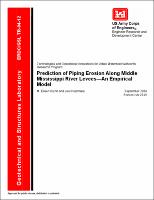Please use this identifier to cite or link to this item:
https://hdl.handle.net/11681/10515| Title: | Prediction of piping erosion along middle Mississippi River levees - an empirical model |
| Authors: | University of Mississippi. Department of Geology and Geological Engineering Technologies and Operational Innovations for Urban Watershed Networks Research Program (U.S.) Glynn, Mary Eileen, 1960- Kuszmaul, Joel |
| Keywords: | Levees Soil erosion Mississippi River Underseepage Mississippi River geomorphology Soil piping Hydrology Levee system Flood control Flooding |
| Publisher: | Geotechnical and Structures Laboratory (U.S.) Engineer Research and Development Center (U.S.) |
| Series/Report no.: | ERDC/GSL TR ; 04-12. |
| Description: | Technical Report Abstract: This research was conducted to address the concerns of U.S. Army Corps of Engineers (USACE) levee engineers regarding the cumulative effects of piping—the movement of sediment from a levee or its foundation by the flow of water. Piping is a levee failure mechanism that has not been analytically defined, but has been observed. Levee inspectors documented an increase in piping from the record flood of 1993 to the lesser flood of 1995 along the Mississippi River. The average net head on the study levee in 1993 was 18 ft and, in 1995, was 10 ft, yet piping incidence was 49 percent greater in 1995. These data support the view that repeated high water events have cumulative effects (increased seepage) and that deficiencies exist in seepage analysis theory. Typically, a seepage analysis is conducted in two dimensions with assumed homogeneous soil properties along a 500- to 1000-ft reach, while in reality piping is a localized failure and occurs near anomalies. Because the current analysis is lacking three-dimensional geologic information and also time-dependent variables, an empirical approach was taken to determine site factors that are significant to piping. A database of seepage parameters was created, and correlation studies were conducted. The levee system (Prairie Du Rocher, IL) was segmented into 349 reaches of equal length (250 ft). The parameters of highest correlation to piping were previous piping locations (P93), the alignment of the geomorphology and the levee footprint (G), the landside blanket thickness (Zb), and effective grain size coefficient of the aquifer (D10). Using multivariate logistical regression (Logit) and the significant parameters, two models for prediction of piping locations were developed for the study levee. The 1993 model predicted 61 reaches as having high piping potential, while only 16 of these reaches actually piped during the 1993 flood. The 1995 model, which included the 1993 piping locations as an independent variable, predicted 26 reaches in the high category, 15 of which actually piped in 1995. The 1995 model predicted fewer reaches in the high category and, therefore, had better predictive capability than the 1993 model. The outcome of the model, prediction of potential locations of piping along these levees, shows promise for predicting piping along the Mississippi River levees in general and other rivers. Also, this research shows that previous piping incidence is the most influential factor in the prediction of future piping and as an indicator of cumulative effects. Therefore, the authors strongly suggest that a standard method for documenting piping (as presented in this report) be adopted by USACE. NOTE: This is a revised edition of ERDC/GSL TR-04-12, first published in September 2004. This edition was published in July 2010. |
| Rights: | Approved for public release; distribution is unlimited. |
| URI: | http://hdl.handle.net/11681/10515 |
| Appears in Collections: | Technical Report |
